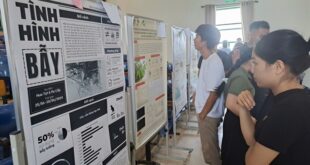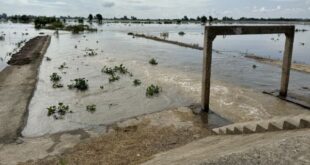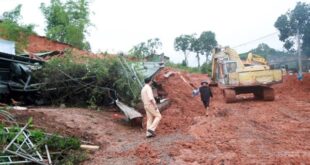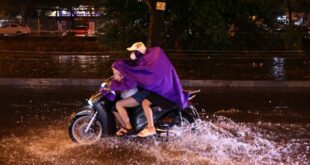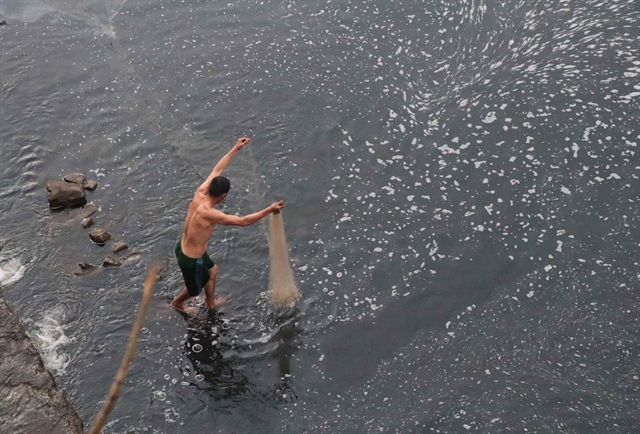
Minh Nguyệt
HÀ NỘI — The environment is suffering great pressure from socio-economic activities with an increase in environmental pollution both in quantity and scale, calling for more effective solutions to handle the issue.
The appearance of extreme weather, pollution hotspots at river basins and air pollution are among the main sources of pollution that have worsened in recent years.
According to experts, extreme weather phenomena used to occur in specific seasons but they have recently occurred all year around, even in months that they had rarely appeared previously, such as severe cold spells in northern mountainous areas, drought and rains in the central region and drought and saltwater intrusion in the south.
In 2020, Việt Nam suffered 16 kinds of natural disasters, including storms, whirlwinds, heavy rains, flash floods, landslides, earthquakes, drought and saltwater intrusion, causing great human and property loss.
In the first 10 months of 2021, Việt Nam was hit by eight storms; three low tropical pressure fronts; 109 small earthquakes; 316 bouts of hail, whirlwinds and lightning; 140 heavy rains and flash floods; 157 landslides at riversides; seven extreme hot weather spells; and six cold spells. Total damage was estimated at more than VNĐ1.4 trillion (US$60 million).
Drought and saltwater intrusion have become more severe. In 2016, people in central and southern regions suffered the most severe drought and saltwater intrusion over 90 years, which affected 50 provinces and cities. Many localities had to announce an emergency state of drought and saline intrusion.
In the 2019-2020 dry season, saltwater intrusion affected 10 out of 13 Mekong Delta provinces, causing water shortage for almost 96,000 households.
The Ministry of Natural Resources and Environment also reported increasing pollution at many major canals, particularly at the Bắc Hưng Hải irrigation system, which includes a main dredged canal of more than 232km, branch canals of about 2,000km, as well as dams, dykes and pumping stations – spanning the three northern provinces of Hải Dương, Hưng Yên, Bắc Ninh and part of Hà Nội.
Due to rapid industrialisation and urbanisation in the area in the last few decades, untreated wastewater from industrial zones, craft villages and residential areas have seriously polluted the irrigation system.
The total amount of wastewater discharged into the Bắc Hưng Hải system reached over 453,000 cubic metres per day, according to Deputy Head of the Vietnam Environment Administration Hoàng Văn Thức.
Over 58 per cent was household wastewater from residential areas. Nearly 60 per cent of the household wastewater discharged into the system were untreated.
Air pollution
Air pollution continues to be one of the hot issues of great public concern, particularly in large cities, urban areas and industrial zones, especially PM10 and PM2.5 pollution.
According to the Vietnam Environment Administration, the PM10 and PM2.5 concentration measured by all automatic observation stations in Hà Nội during 2018-20 was 1.1-2.2 times higher than the national mandated threshold.
In 2020, Việt Nam registered 10 out of 63 provinces and cities with higher PM2.5 concentration levels than the national mandate.
Major sources of PM2.5 pollution in Việt Nam came from burning agricultural by-products, cooking, transport, forest fires, industrial activities and thermal power.
Việt Nam is ranked 115th in air quality for household solid fuel use and PM2.5 average exposure, according to in the biennial Environmental Performance Index compiled by scientists at US universities Yale and Columbia.
According to the World Health Organization, air pollution is one of the greatest environmental risks to health. By reducing air pollution levels, countries can reduce the burden of disease such as stroke, heart disease, lung cancer, and both chronic and acute respiratory diseases, including asthma.
The organisation estimated that in Việt Nam around 60,000 deaths each year were air pollution-related.
Solutions
As the COVID-19 pandemic is expected to continue developing complicatedly, negatively affecting all aspects of life, Việt Nam is forecast to continue facing environmental challenges, and the Ministry of Natural Resources and Environment has identified key tasks to improve environmental protection.
Environmental protection needs to focus on building and developing the circular economy; innovating environmental management methods in digital transformation; strengthening household solid waste management to fully tap the value of resources; and enhancing conservation of nature and biodiversity, according to the ministry.
The ministry is implementing the national environmental protection strategy until 2030, with the key tasks of promoting the circular economy, green growth, sustainable production and consumption; handling key environmental issues; improving environment quality, conservation of nature and biodiversity; and enhancing the capacity to cope with climate change and reduce greenhouse gas emissions.
The ministry has built a system of national technical standards on the environment, including standards on waste management. Solid waste management will focus on household solid waste and plastic waste with the implementation of a pilot programmes on waste classification from sources.
A national action plan on maritime plastic waste management until 2030 and a plan to implement the master project on enhancing plastic waste management in Việt Nam have been issued.
The country has been implementing a national plan on climate change adaptation for 2021-30; speeding up scientific research and application of technology as well as boosting international cooperation in coping with climate change; and improving forecast capacity to prevent natural disasters and mitigate their impact.
The revised Law on Environmental Protection, which will take effect from January 2022, is expected to create a breakthrough in protecting the environment with many comprehensive policies.
Deputy Head of the Vietnam Environment Administration Nguyễn Hưng Thịnh said the law introduced a series of comprehensive policies such as a national environmental protection strategy, environmental impact assessment, household solid waste management; coping with climate change; environmental observation; preventing and handling environmental incidents; and environmental protection inspection.
The implementation of these policies will help improve the efficiency of environmental protection, he said. — VnExpress News
- Reduce Hair Loss with PURA D’OR Gold Label Shampoo
- Castor Oil Has Made a “Huge” Difference With Hair and Brow Growth
- Excessive hair loss in men: Signs of illness that cannot be subjective
- Dịch Vụ SEO Website ở Los Angeles, CA: đưa trang web doanh nghiệp bạn lên top Google
- Nails Salon Sierra Madre
 VnExpress News The News Gateway of Vietnam
VnExpress News The News Gateway of Vietnam
